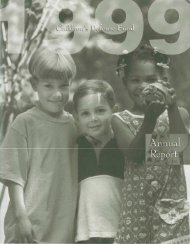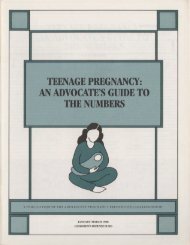child care - Digital Library Collections
child care - Digital Library Collections
child care - Digital Library Collections
Create successful ePaper yourself
Turn your PDF publications into a flip-book with our unique Google optimized e-Paper software.
THE STATE OF AMERICA'S CHILDREN YEARBOOK 1998<br />
serves both girls and boys, engaging them in supervised<br />
volunteer work in the community, classroombased<br />
discussions, and activities related to key<br />
social-developmental tasks of adolescence. Students<br />
are both self-selected and recommended by<br />
their teachers.<br />
Ingredients for success. The philosophy behind<br />
TOP is based on research fIndings that problem<br />
behaviors among teens occur in clusters, not as<br />
single events. The expectation, therefore, is that<br />
well-designed interventions can bring results on<br />
several fronts at the same time. The TOP approach<br />
focuses on four interrelated strategies:<br />
• Youth development. To help young people<br />
achieve their full potential, TOP sets high expectations<br />
and clear standards, engages teens<br />
in meaningful activities, provides opportunities<br />
for them to contribute, and fosters lasting<br />
relationships with caring, supportive adults.<br />
• Community involvement. TOP participants undertake<br />
service-related activities that reconnect<br />
them to their communities. All sectors of<br />
the community support such efforts.<br />
• Learner-centered education. The classroom<br />
component of TOP is guided by a curriculum,<br />
"Changing Scenes." Young people do most of<br />
the talking, and adults act as guides in discussions<br />
about observations and emotions. Both<br />
the classroom activities and the community<br />
service projects emphasize hands-on learning.<br />
• Academic extensions. Teens have an opportunity<br />
to apply what they learn in school to the<br />
positive development of their communities.<br />
Using interdisciplinary learning techniques,<br />
TOP facilitators help students connect skills<br />
learned in core school subjects to workplace<br />
requirements in their service assignments.<br />
What sets TOP apart from many other prevention<br />
programs is that it does not explicitly focus on<br />
the problem behaviors it seeks to prevent. Instead<br />
it works on enhancing teens' competence in decision<br />
making, interacting with peers and adults, and<br />
identifying and handling their own emotions. Ac-<br />
cording to Dr. Joseph Allen, professor of psychology<br />
at the University ofVirginia and one ofTOP's<br />
primary evaluators, this approach means that the<br />
program "may be politically acceptable in communities<br />
where programs that explicitly focus upon<br />
sexual behavior may not be feasible to implement."<br />
Payoffs for participants. Since 1978, when the<br />
program began, TOP has made a difference in the<br />
lives ofmore than 12,000 young people. In the most<br />
recent nationwide evaluation, conducted between<br />
1991 and 1995 and published in August 1997, 700<br />
high school students at 25 sites with Teen Outreach<br />
Programs were randomly assigned to either TOP or<br />
a control group. When their circumstances were<br />
compared at the end of the nine-month program,<br />
rates ofpregnancy, school failure, and academic suspension<br />
were substantially lower among those who<br />
attended TOP. They demonstrated an II percent<br />
lower rate of course failure in school, 14 percent<br />
fewer school suspensions, a 60 percent lower dropoutrate,<br />
and 33 percentfewer pregnancies. Students<br />
said thatwhat affected their behavior mostwas "feeling<br />
safe," "being listened to and respected," "having<br />
input in selecting the work they do," and being encouraged<br />
to see themselves as competentindividuals<br />
who could be autonomous but still connected to<br />
other young people and adults.<br />
The extent to which TOP can be expanded to<br />
other sites or successfully replicated elsewhere depends<br />
on a community's capacity to commit resources<br />
and human energy to reproducing TOP's<br />
critical elements. Local models can be school-led,<br />
community-sponsored, or jointly developed by educators<br />
and community leaders, but the core principles<br />
and components cannot be compromised if<br />
success is to occur.<br />
Moving Forward: A 1998 Agenda<br />
for Action<br />
T:e problems that plague so many teenagers<br />
today, including pregnancy, cannot be overcome<br />
unless we find ways to give these young<br />
people a belief in themselves and their futures. If<br />
they are to develop their full potential, they must<br />
100 CHI L D R EN' S D E FEN S E FUN D














